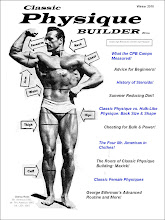
(Above Photo: Classic Physique Builder
Bob McCune - 1947 Mr. Muscle Beach - 2nd, 1949 Pro. Mr. America - 2nd, 1949 Mr. California - 2nd)
These days, it seems that many weight trainers immersed in the mainstream bodybuilding world obsess over their % body fat! On many internet forums, you can even see beginners discussing their body fat % goals (trying to get it down to single digits) - even when their accompanying photos show that they are no where close to attaining a classic physique in terms of mass and proportion! This is nothing new. In the Dec. 1952 issue of
Your Physique (one of Joe Weider's Golden Age muscle mags), Reg Park said this: "In fact, it is common to hear many novices talk of definition development before they have even built the foundations of a good physique"!
For some perspective, in the pre-roid, Golden Age (the 1940s and 50s), % body fat was never discussed! Steve Reeves, Reg Park, George Eiferman, or any of the other Golden Age champs never obsessed over their % body fat! There were no articles in the Golden Age muscle mags discussing % body fat! Yet, look at how fantastic their classic physiques looked!
Of course, they did discuss "muscular separation," "definition," and "skin thickness." They certainly knew that in order to look their best before a contest, they would have to increase their definition by changing their diet and their training routine. This brings us to our main point:
build your physique to classic size and proportions first, then strive for classic definition! Again, here is Reg Park (same article) making the same point:
"A programme which is designed to produce greater muscular separation is what is commonly known as a 'SPECIALIZATION' programme. It is NOT for the newcomer to bodybuilding. It IS for the advanced man, the guy who has a couple of years training under his belt and wants to IMPROVE his appearance."
And even when they undertook specialized training and changed their diet for increased definition, they still did not obsess over % body fat. So what did they strive for? It wasn't single digit body fat % or extreme vascularity! They strove for classic muscle separation and defined abs. They knew that their skin was expected to have a "healthy glow" about it, so they didn't strive for an extreme cadaver-like look. They probably had no idea what their body fat % was, yet look at how fantastic their physiques were!
For most of us non-competitive, classic physique builders, what can we learn from this? If your body weight is fairly normal then
strive to build your overall mass to classic physique size and proportions first. You will probably gain some weight around the middle (it's tough to gain mass without gaining some fat), but don't worry unless it is excessive. Once your neck, arms, calves, chest, and thighs have reach classic size and proportions,
then work on classic definition. When you get to that point, don't obsess over body fat %! Who cares?! It doesn't matter whether your body fat level is 10%, 13% or 15% - as long as you have that classic, Golden Age look of health, vitality, muscularity, power, and symmetry! Let the mirror be your guide! Chances are very good that if you can see your "six pack" and don't have a "spare tire" around the middle, then your definition will be just fine!
-
CPBP.S.
For a free 1 year subscription to
Classic Physique Builder (
CPBzine) - a pdf zine patterned after the muscle mags of the pre-roid Golden Age (1940s and 50s), just send us an email to
cpbzine@gmail.com and give us your name, the name of your city (not your address), state or province, and country. That's it! All info you send us is strictly confidential and you won't find yourself on any spam lists, etc. (you won't even get automated emails from us)!











